Updated: 07-Sep-2019
The Heinkel AG factory was totally dedicated to the manufacture of aircraft.

“Ernst Heinkel”
-But in 1936 Professor Pohl dissuaded Ernst Heinkel to intervene in a project of his former student, Professor Von Ohain. This project was a gas turbine engine for aircraft propulsion. Heinkel accepted and he had his company entering into a new era.
-Then, in Heinkel's small garage workshop, Von Ohain with the help of fellow student, Max Hahn, built what was known as the HeS-1.

“Max y el HeS-1”
-The HeS-1 gave precarious results. It is said that at this time Von Ohain did not know Frank Whittle's studies or those that A. Lysholm did in Sweden, sponsored by Milo AG.
-The HeS-1 (the S is Strahl = Jet) had a centrifugal compressor, a peripheral chamber and a centripetal turbine.
-It had the same architecture as the turbochargers on current land vehicles regarding the rotating group.
-For its operation, he tried first with gasoline but there were vaporization problems and he changed over to use hydrogen.
-It gave just 250 Kgf of thrust, but with an exaggerated total diameter. This was in 1937.
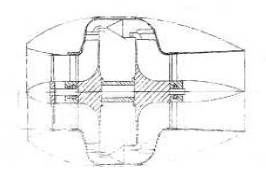
“HeS-2”
-The HeS-2 of 1938, was being developed with the intention to fly. This time hydrogen gas was used for starting, and once the vaporizers were running it changed to liquid fuel.
-It was planned for 500 Kgf of thrust, but in the first tests gave less than half of it.
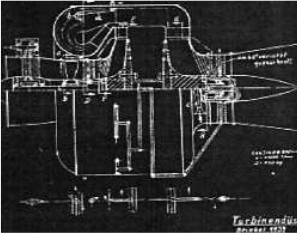
“Heinkel HeS-3b”
-It was being modified until finally coming to the HeS-3, of which we show an original "Blue Print" made by engineer W. Gundermann at Heinkel in 1939.
-The first HeS-3a was tested in flight under a He-118, and that year it gave 400 Kgf of thrust on the ground, improving it and increasing it to 450 Kgs on that flight.
-At the same time the He-178 was being built, and was designed around the HeS-3b.
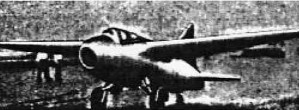
“Heinkel He-178”
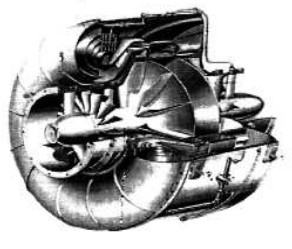
“Heinkel HeS-3b”
-It turned out that both the long intake duct and the exhaust nozzle subtracted power from the engine.
-Finally, on August 24, 1939, the first flight of a jet plane with a turbine engine had taken place.
-The maximum power was 380 Kgf of thrust.
-Starting was done by compressed air on the exhaust turbine.
-As Heinkel was considered as an aircraft builder by the authorities, he did not get the necessary help to advance in his engine trials.
-That is why, in 1941, he began the participation with Hirth, with the intention of carrying out his turbine programs.
-The purchase of Hirth culminates in 1943 and from these moments their engines are known as Heinkel-Hirth.
-With the new HeS-6 version the plane flew with 450 Kgf of thrust.
-After this engine the HeS-8 appeared with the designation of 109-001.
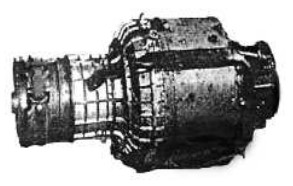
“Heinkel HeS-8”
-To eliminate the losses of admission and nozzle a new twin-engine plane was designed with the engines under the wings.
-The new engine had a smaller diameter, because instead of a centrifugal compressor there was a mixed axial-centrifugal one, and the chambers were more integrated between the compressor impeller and the turbine.
-These differences can be seen between the first HeS-3b with its peripheral and inverted combustion chambers at the front of the engine and those of the HeS-8a with the aforementioned arrangement.
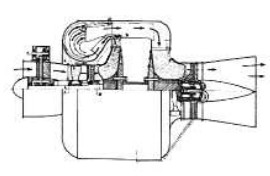

"Differences between HeS-3b and HeS-8a"
-The flight tests with the HeS-8a were carried out under the belly of a Heinkel He-111.
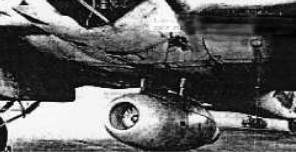
"For flight tests"
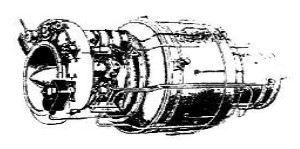
“HeS-8a”
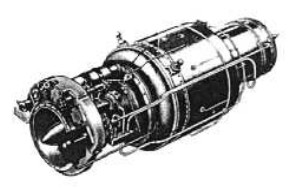

“HeS-8a, exterior and interior”
-The HeS-8a gave 480 Kgf initially and soon reached 700 Kgf of thrust. The front diameter was only 776 mm.

“HeS-8 V16”

"Differences between HeS-8V15 and HeS-9"
-The HeS-9 should have been a development of the HeS-8a-V15. It did not prosper.
-The HeS-10 was a turbofan design evolved from the HeS-8.


"Drawing and photo of -011"
-It had a mixed compressor composed of a 3-step axial stage and one diagonal stage. The chamber was annual with 16 burners and two-stage axial turbine.
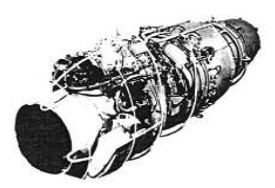
“Heinkel -011a version”
-In 1951, the Spanish National Institute of Industry (INI) signed a contract to build the HeS-011 in Spain by CETME and INTA.
-At that time, the 011 already delivered 2,500 Kgf of thrust. It was known as INI-11 and presented as the first Spanish turbojet engine. The project was done by German and Spanish personnel together until the year 1956, when the program was set aside. Three test units were built. One is being restored at the Cuatro Vientos Air Museum.
-Heinkel-Hirth also had a project based on the -011 to transform it into a turboprop, it was known as the HeS-021, but it did not come to an end.
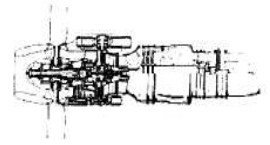
“Heinkel HeS-021”
-The HeS-021 project was retaken by Daimler-Benz who continued the program (see Daimler-Benz).
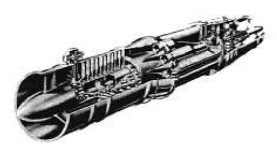
“HeS-30”
-Another interesting engine was the HeS-30 that was abandoned just at the beginning of its development. Officially it was the 109-006.
-Nevertheless it was a promising project, of apparent simplicity and it had an architecture that was very similar to certain later American engines like the J-35 and J-47, and even to some English engines like RR Avon, for example.
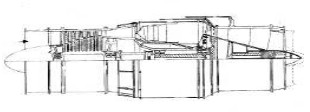
“HeS-30”
-From the HeS-40 there is hardly any information. It is only known that instead of working with the constant pressure principle, it was carried out under the constant volume cycle, the pulsejet principle.
-This was difficult to carry out in a constant-flow turbine. It was generally based on HeS-30 parts.
-Only the combustion chambers differed: they were separate, with a free outlet and an automatic poppet-type intake valve.
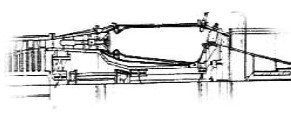
“HeS-40 combustion chamber”
-In the figure we see the "mushroom" type valve. It is not known for sure if there was any experimental engine.
-We continue with two projects by Dr. Mueller and his group. These projects were directed towards what we now know as "Ducted Fan", and were realized with the HeS-50 and HeS-60 engines.

“HeS-50”
-They were simply "motorjets", that is, piston engines that are driving a 3-stage multiple fan.
-A system that recalls in part to the one used by Caproni-Campini in its CC.1 and CC.2, but without afterburner, the exhaust gases increased the air volume of the surrounding flow.
-The engine that was going to be used was one from a FKFS project. It was a 16-cylinder, 2-stroke, X-engine that ran on Diesel.
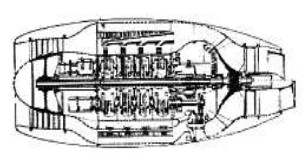
“HeS-60”
-The HeS-60 was designed to replace the HeS-50. It had a rear turbine to recover energy from the gases heated by the exhaust.
-It was more powerful than the previous one and it had a lower equivalent of consumption. The Diesel engine was a 2-stroke one, and had 32 cylinders in 8 rows of four in the shape of a crossed H. This involved 4 crankshafts that were geared to a central shaft. The engine delivered 525 Kgf of thrust.

“Heinkel-Hirth, HeS-11-V1”
-In short, the most operational turbojet engine (even considered by the German government as Class II) was the 109-011 (HeS-011), of which there were quite a few variants such as V1 and V5, V6, V25 and AO as the best known.
-From the AO version the HeS-021 (and DB-021) would be derived.

“HeS-021”
-The nozzles could be adjusted according to the operation.
-As in its Junkers Jumo and BMW congeners, the start-up was carried out with the fast Riedel piston engine (see), a 2-stroke engine with a hand starter.
-They were made by Norbert Riedel HG in Murssendorf.
-It is interesting to note that the injectors used by the HeS-011 were already Duplex with a concentric double nozzle to generate a "tulip" for low speed and another larger one for higher speeds.
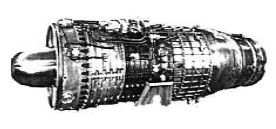
“053”
-In 1953, Professor Heinkel, on behalf of the Egyptian government developed the HeS-53 with a variable nozzle delivering 9,000 Kgf of thrust. It was very similar to the Atar and Avon.
From Appendix 9: As we saw in the main text, reaction engines are developed, now we have some illustration to shown them.
-As a curiosity, some readers relate the specification of Heinkel engines with Henschel to be written as HeS.These are the initials of Heinkel Strahlmotor. (Jet engine).
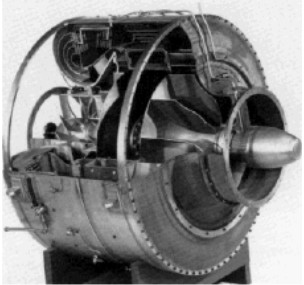
“HeS-3B cutaway at a museum”

“HeS-30 drawing" (PiP)
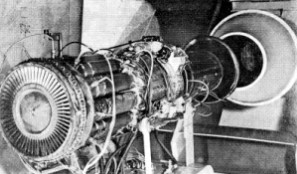
“HeS-30 on a bench” (PiP)

“HeS-40 schematic drawing” (PiP)
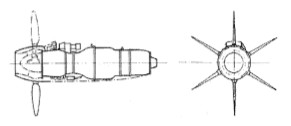
“Heinkel HeS-021”
-The HeS-021 had a very interesting application project. To be installed on the Heinkel Wespa vertical take-off and landing plane.

“The Wespa from 1944” (PiP)
-The peculiar shape of the plane was forced by the engine. The HeS-021 was a turboprop whose propeller was tubed in a polygon circle of aerodynamic profiles.
-The residual exhaust, like in the first turboprops, gave a not inconsiderable thrust, so it was directly directed back to add propulsion power to the traction of the six-blade propeller.
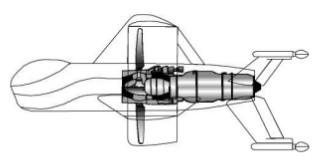
“Wespa design and engine layout”
-The air intake for the engine was at the front, just below the cockpit.
Engines of HEINKEL
Model: HeS-1
Arquitecture: Turbojet
Compressor/s:
Combustion chambers:
Turbines:
Power / Thrust: --- / 250 Kgf
Weight:
Model: HeS-10
Arquitecture: Turbofan
Compressor/s: Mixed compressor: 3-step axial stage and one diagonal stage
Combustion chambers: Annual chamber with 16 burners
Turbines: Two-stage axial turbine
Power / Thrust:
Weight:
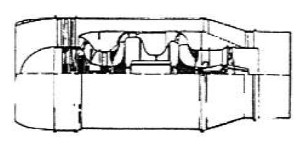
"Heinkel HeS-10 drawing"
Model: HeS-11 (HeS-011, 109-011)
Arquitecture: Turbojet
Compressor/s: Diagonal with 3-stage axial
Combustion chambers: 16 chambers
Turbines: Two-stage axial turbine
Power / Thrust: --- / 1300
Weight:

"Heinkel HeS-11"
Model: HeS-11a
Arquitecture: Turbojet
Compressor/s: Diagonal with 3-stage axial
Combustion chambers: 16 chambers
Turbines: Two-stage axial turbine
Power / Thrust: --- / 1300
Weight:

"Heinkel HeS-11a"
Model: HeS-2
Arquitecture: Turbojet
Compressor/s:
Combustion chambers:
Turbines:
Power / Thrust:
Weight:

"Heinkel, HeS-2 drawing"
Model: HeS-21 (HeS-021, 109-021)
Arquitecture: Turboprop
Compressor/s:
Combustion chambers:
Turbines:
Power / Thrust:
Weight:

"Heinkel HeS-21"
Model: HeS-3
Arquitecture: Turbojet
Compressor/s:
Combustion chambers:
Turbines:
Power / Thrust:
Weight:
Model: HeS-30 (109-006)
Arquitecture: Turbojet
Compressor/s: Five-stage axial compressor
Combustion chambers: 10 cannular combustion chambers
Turbines: 1 axial stage
Power / Thrust: --- / 850 Kgf
Weight: 390 Kg

"Heinkel HeS-30 cutaway"
Model: HeS-35
Arquitecture: Turbojet
Compressor/s: 14-blade axial inducer + 16-blade centrifugal compressor
Combustion chambers: Reverse-flow annular chamber
Turbines: 12-blade radial inflow turbine
Power / Thrust: --- / 500 Kgf
Weight: 360 Kg
Model: HeS-36
Arquitecture:
Compressor/s:
Combustion chambers:
Turbines:
Power / Thrust: / ---
Weight:
Model: HeS-3b
Arquitecture: Turbojet
Compressor/s:
Combustion chambers:
Turbines:
Power / Thrust: --- / 380 Kgf
Weight:

"Heinkel HeS-3B engine cutaway"
Model: HeS-40
Arquitecture: Turbojet
Compressor/s:
Combustion chambers:
Turbines:
Power / Thrust:
Weight:
Model: HeS-50d, z
Arquitecture:
Compressor/s:
Combustion chambers:
Turbines:
Power / Thrust:
Weight:
Motorjet

"Heinkel HeS-50 drawing"
Model: HeS-53
Arquitecture: Turbojet
Compressor/s:
Combustion chambers:
Turbines:
Power / Thrust: --- / 9000 Kgf
Weight:

"Heinkel HeS-53"
Model: HeS-6
Arquitecture: Turbojet
Compressor/s:
Combustion chambers:
Turbines:
Power / Thrust: --- / 450 Kgf
Weight:
Model: HeS-60
Arquitecture:
Compressor/s:
Combustion chambers:
Turbines:
Power / Thrust:
Weight:
Motorjet

"Heinkel HeS-60 drawing"
Model: HeS-8 (109-001), V15, V16
Arquitecture: Turbojet
Compressor/s:
Combustion chambers:
Turbines:
Power / Thrust: --- / Kgf
Weight:

"Heinkel HeS-8"
Model: HeS-8a, aV15
Arquitecture: Turbojet
Compressor/s:
Combustion chambers:
Turbines:
Power / Thrust: --- / 700 Kgf
Weight:

"Heinkel HeS-8a outside"
Model: HeS-9
Arquitecture: Turbojet
Compressor/s:
Combustion chambers:
Turbines:
Power / Thrust:
Weight:
Model: HeS3a
Arquitecture: Turbojet
Compressor/s:
Combustion chambers:
Turbines:
Power / Thrust: --- / 450 Lbf
Weight:


